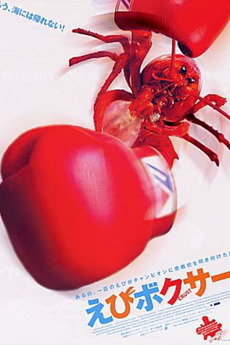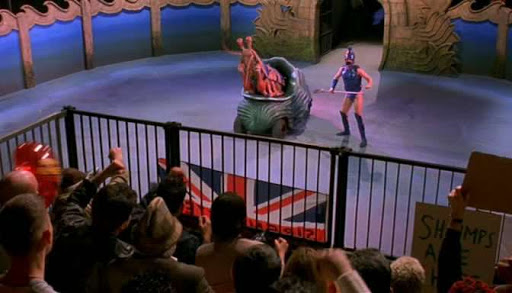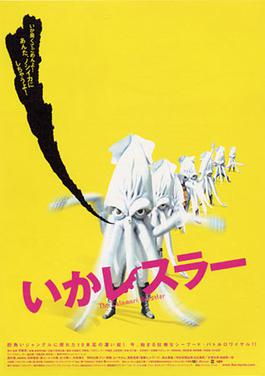Here’s a prime example of the type of filmic simultaneity that I so enjoy investigating: two films released within a year of each other headlined by man-sized aquatic critters. 2003’s CRUST, from Great Britain, was apparently the direct inspiration for ‘04’s THE CALAMARI WRESTLER (IKA RESURAA), from Japan, as the former film, about a boxing shrimp, was screened in Japan (to great success) in July of ‘03, a full year before THE CALAMARI WRESTLER, about a wrestling squid. In fact, CRUST is said to have single-handedly spawned the Japanese “sea-life sport movie,” although this genre’s sole examples appear to be CALAMARI and 2006’s KANI GOALKEEPER (KANI GORUKIPA), in which a silly looking crab becomes a goalkeeper.
Goofy monster movies are certainly nothing new, particularly in Japan. Nor is Japanese cephalopod themed art, which stretches back to the feudal era (often picturing octopi in erotic encounters with human women). That’s in addition to non-Japanese films like OCTAMAN (1971), featuring an octopus suited individual who bears a more-than-passing resemblance to the title character of THE CALAMARI WRESTLER, and the Sid and Marty Croft children’s series SIGMUND AND THE SEA MONSTERS (1973-75), whose tentacled sea monster heroes likewise forecast the goofiness of CALAMARI. Crustacean critters, a la the one from CRUST, are less common, but they do exist; who can forget the giant lobster that turns up to rape Divine near the end of John Waters’ MULTIPLE MANIACS (1970)?
Why was it in 2003/04 (when the film world was attempting shake off the faux-edginess of the previous decade) that the idea of turning rubber squid and shrimp into professional fighters finally germinated? Your guess is as good as mine.
CRUST, written and directed by Mark Locke, is essentially what you’d expect. Concocted, allegedly, as an elaborate tax dodge, the film was given a supremely truncated release in the Western world, much to the consternation of its backers. Among the latter was the outspoken British investor Guy Hands, who was duped into pumping money into Little Wing Films, and in doing so lost a reported $34 million. CRUST wasn’t the only film put out by Little Wing, but it was the most notorious, and the one that’s always mentioned in news reports about Hands’ investment.
CRUST was acclaimed, FYI, by the late Ken Russell, but keep in mind that Russell was nearing the end of his life when he made that claim, and so his praise can be blamed on senility. In truth the most impressive aspect of CRUST is that, simply, it’s competently made—not well made, but competent.
 The “drama” is played fairly straight, albeit with snatches of unfunny comedy—example: a sex scene in which a character, apparently seeking to replicate the notorious butter scene in LAST TANGO IN PARIS, produces a tub rather than a stick of butter, because “it’s cheaper” (yes, that’s the joke). Much of the budget appears to have gone into the eponymous critter, an elaborate animatronic crustacean that, after it washes up on a beach in England, is procured by a goofy pub owner (Kevin McNally) looking to make some quick cash by making “Crust” the main contender in a widely publicized boxing match.
The “drama” is played fairly straight, albeit with snatches of unfunny comedy—example: a sex scene in which a character, apparently seeking to replicate the notorious butter scene in LAST TANGO IN PARIS, produces a tub rather than a stick of butter, because “it’s cheaper” (yes, that’s the joke). Much of the budget appears to have gone into the eponymous critter, an elaborate animatronic crustacean that, after it washes up on a beach in England, is procured by a goofy pub owner (Kevin McNally) looking to make some quick cash by making “Crust” the main contender in a widely publicized boxing match.
McNally is evidently supposed to be far more endearing than he comes off, as his tiresome antics fill much of CRUST’s first hour. It takes until the final third for the shrimp to finally enter the ring, and the resulting CGI-enhanced kerfuffle is a disappointment. A too-low budget appears to be the culprit, resulting in several not-very-inspiring scuffles that all seem to begin and end with Crust punching out his opponents and sending them flying (the thing can’t seem to do much else). It all concludes, at least, with an underwater jolt that’s easily the most affecting element of the entire film.
THE CALAMARI WRESTLER, to its credit, doesn’t waste any time. Co-writer/director Minoru Kawasaki plunges us directly into the madness with a pro wrestling match interrupted by the giant squid—actually a guy in a ridiculous squid costume—protagonist. This personage is actually the reincarnation of a deceased wrestler, and its appearance causes a huge upheaval in the Japanese wrestling community. As the Calamari Wrestler gets back together with its previous incarnation’s GF, a walking octopus shows up to take on our “hero” in the ring, followed by a lobster (a direct nod to CRUST).
pro wrestling match interrupted by the giant squid—actually a guy in a ridiculous squid costume—protagonist. This personage is actually the reincarnation of a deceased wrestler, and its appearance causes a huge upheaval in the Japanese wrestling community. As the Calamari Wrestler gets back together with its previous incarnation’s GF, a walking octopus shows up to take on our “hero” in the ring, followed by a lobster (a direct nod to CRUST).
The film is an enjoyable enough trifle, and even makes some pertinent points about media exploitation. But it’s sanitized PG-rated stuff that would have benefited from a darker, grittier edge. And then there’s the downright vomitous happy ending, wherein all the critters are inexplicably changed back into the people they once were.
THE CALAMARI WRESTLER was by no means a hit, but it was better received than CRUST. This is evinced by the fact that the latter film’s creator Mark Locke has for the most part gone silent in the years since its release (his only subsequent directorial credit is a little-seen short entitled TOWNIES), whereas THE CALAMARI WRESTLER’S Minoru Kawasaki has been quite prolific. Granted, Kawasaki’s post 2004 films, which bear titles like THE WORLD SINKS EXCEPT JAPAN, PUSSY SOUP, MONSTER SEAFOOD WARS and the aforementioned KANI GOALKEEPER, aren’t anyone’s idea of Classics for the Ages.
Perhaps the most interesting of those films is EXECUTIVE KOALA (KOARA KACHO) from 2005. It’s not a sea-life sport movie, but like THE CALAMARI WRESTLER features a goofy looking animal-suited title character—a businessman koala in this case, who may or may not be a murderer. As in the previous film, the aim was to insert this personage into a more-or-less straightforward drama, with surrounding human characters totally unfazed by the presence of it, or the (apparently deliberate) cheapness of the koala costume (note the visible zippers). That approach worked reasonably well in CALAMARI, but not so much here, as the film just isn’t serious or outrageous enough.
What might EXECUTIVE KOALA, CRUST or THE CALAMARI WRESTLER have to say about life, the cinema or anything else? I don’t know, and nor am I too sure that the question is worth pondering at any length. But for those of you interested in unfettered goofiness these films are mandatory viewing.
